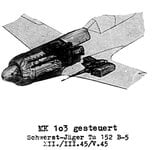Note that my suggested 'baby MK 103' is firing a much weaker load than the historical MK 103, thus the variation between the propellant weights in different ammo will be smaller. Germans moved to the electricly-primed MK 103 by 1943, that insures as uniform ignition and lower loss of RoF on the synchronised guns.The issue with 30mm guns in wing roots is the combination of the variability of the action and the variability of the power burn.
With higher rate of fire guns, both wing root guns are guaranteed ready when the 'signal' is given to fire at reasonable of fire for synchronized guns. With both guns firing, the aircraft remains a steady gun platform..But when you get into larger individual weapons, you have to slow the rate of fire way down to ensure both guns are charged - which slows firing rate way down.The other challenge is not shooting your own propeller off. Unfortunately, with the amount of power being burned in 30mm casing, and the difference in burn times between cold and hot temperatures, it becomes more than the time difference between propeller blades coming into line of fire. More of issue with MK 103 as it has more powder, but definitely concern. For some reason, pilots have real concerns about their propellers being shot off....
FWIW, Germans (FW actually) were willing to give a go to the idea of two historical MK 103s to be installed within the Ta 152 wing roots; not that I'm subscribing to the idea 100%, but it probably warranted a look back then:

